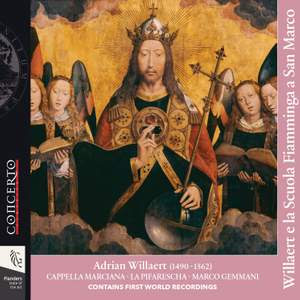Program: #20-31 Air Date: Jul 20, 2020
To listen to this show, you must first LOG IN. If you have already logged in, but you are still seeing this message, please SUBSCRIBE or UPGRADE your subscriber level today.
Adrian Willaert and his circle at San Marco, the Lamentations of Morales, and sacred song from around 1500 with The Boston Camerata.
I. Willaert e la Scuola Fiamminga a San Marco (Cappella Marciana/La Pifarescha/Marco Germani). Concerto CD 2117.

II. Treasures of Devotion: European Spiritual Song c. 1500 (The Boston Camerata/Anne Azéma). Music and Arts CD 1296.

These objects draw viewers into a private and intimate world of meditation; religious scenes carved with precision and poetry evoke a bygone world of intense spiritual devotion—sometimes tormented, sometimes luminous, but always fascinating.
The music in this program is designed to elicit similar sensations in listeners. Originating in northern European circles, contemporary with those who produced these boxwood carvings, these spiritual pieces are not intended for grand cathedrals or public ceremony, but for personal meditation, private chapels and rooms, family houses and assemblies. Like the beads and rosaries, their craftsmanship is precise, superb; rich in subtle details, they lead us to wonder, and to contemplation.
-
- Fortuna Desperata/Sancte Petre/Ora pro nobis Heinrich Isaac (ca 1450-1517) - Barrett, Hershey, Kammen, Lewis, Arceci
- Fortuna Desperata/O morte, dispietata Alexander Agricola (1446-1506) - Azéma, Barrett, Frederiksen, Kammen, Lewis, Arceci
- Herre lieve Herre Jacob Clemens non Papa (1510-1555) – Kammen, Lewis, Arceci, Hershey, Barrett, Frederiksen
- De tous biens plaine Hayne van Ghizeghem (ca 1445- after 1476) - Kammen, Lewis, Arceci
- Maria Zart Arnold Schlick (1455-1525) Hershey, Lewis (trebble viol), Frederiksen (lute)
- De tous biens plaine Alexander Agricola (1446-1506) – Kammen, Lewis, Arceci
- De tous biens plaine Josquin Desprez (ca 1450 - 1521) - Barrett, Kammen, Lewis, Arceci
- De tous bien plaine Alexander Agricola (1446-1506) – Frederiksen (lute), Kammen, Barret (lute), Lewis, Arceci
- Chantons Noël, menons joyeuse vie Pierre Certon (d.1572) & Jean Daniel (ca 1520) - Tutti
- Premier Branle de Bourgongne Adrian le Roy (1551) – Frederiksen (lute), Accurso
- Or vous tremoussez, pasteurs de Judée Anonymous (15th c.) & Jean Daniel (ca 1520) Azéma, Hershey, Barrett (lute and voice), Frederiksen (lute and voice), Kammen, Lewis, Arceci
- Et d'où venez vous Madame Lucette Pierre Moulu (ca 1540) – Kammen, Lewis, Arceci
- Amy souffrés Pierre Moulu ? (1484-1550) (in: Attaignant, 1519) – Frederiksen, Barrett (lute), Acurso
- Pêcheurs souffrez Pierre Moulu ? (1484-1550) & Jean Daniel (ca 1520) – Azéma, Kammen, Lewis, Arceci
- Ewiger Gott, aus des Gebot Ludwig Senfl (1486-1543) – Barrett, Kammen, Lewis, Arceci
- O bone Jesu Francesco Canova da Milano, after Compère (1497-1543) – Accurso
- O bone Jesu Loyset Compère (1445-1518) – Azéma, Hershey, Barrett, Frederiksen
- Tant que vivray Claudin de Sermisy (1490-1562) & Clément Marot (1496-1544) – Hershey, Barrett, Frederiksen
- Tant que vivray Claudin de Sermisy (1490-1562) & Eustorg de Beaulieu (ca 1495-1552), after Marot – Azéma, Kammen (vielle and harp), Lewis, Arceci, Frederiksen (lute), Barrett (lute)
- Het daghet Anonymous (in: Antwerp Songbook, 1544) – Barrett
- Als ick riep met verlangen Jacob Clemens non Papa (1510-1555) – Hershey, Barrett, Frederiksen, Azéma, Kammen, Lewis, Arceci
- Christe eleison (from: Missa Carminum) Heinrich Isaac (ca 1450-1517) - Azéma, Hershey, Barrett, Frederiksen
- Innsbruck ich muss dich lassen Heinrich Isaac (ca 1450-1517) - Frederiksen, Barrett (lute), Accurso (lute)
- Loven so wilt Jacob Clemens non Papa (1510-1555) – Hershey, Barrett, Frederiksen
- In te Domine speravi Josquin Desprez (ca 1450 – 1521) – Tutti
III. Cristóbal de Morales: Super Lamentationes Hieremiae Prophetae (Capella de Ministrers/Carles Magraner). CdM CD 2048.
From MusicaAntiqua.com: Capella de Ministrers has published Super Lamentationes, Hieremiae Prophetae by Cristóbal de Morales (Seville, 1500 - Marchena o Málaga, 1553), a disc in which he performs the renowned work of the Andalusian composer of the Spanish polyphonist school of the 16th century. This composition of the Lamentations are of extraordinary beauty, and filled with music the central days of the Passion Week (Thursday, Friday and Holy Saturday).
Morales's Lamentations were, together with his masses and magnificats, the composer's best-known works and managed to be widely disseminated in Germany, France, Italy ... through prestigious publishers in cities such as Alcalá de Henares, Antwerp, Lyon, Milan, Nuremberg , Paris, Rome, Seville and Venice, among others. The Sevillian musician was the master of the Chapel of the Cathedral of Ávila, the Cathedral of Toledo and Malaga.
Super Lamentationes Hieremiae Prophetae
Cristóbal de Morales (c. 1500 - 1553)
1. Aleph. Quomodo sedet sola
2. Num. Vigilavit iugum iniquitatum
3. Heth. Cogitavit Dominus
4. Zain. Candidiores nazarei
5. Coph. Vocavi amicos meos
6. Phe. Expandit Sion
Composer Info
Adrian Willaert (1490-1562), Cipriano de Rore (c.1515-1565), Jacques Buus (c.1500-1565), Petrus Lupus (c.1590-after 1530), Heinrich Isaac (ca 1450-1517), Cristóbal de Morales (1500-1553)Alexander Agricola (1446-1506), Jacob Clemens non Papa (1510-1555), Hayne van Ghizeghem (ca 1445- after 1476), Arnold Schlick (1455-1525), Josquin Desprez (ca 1450 - 1521), Pierre Certon (d.1572), Jean Daniel (ca 1520), Adrian le Roy (1551), Pierre Moulu (1484-1550), Ludwig Senfl (1486-1543), Compère (1497-1543), Loyset Compère (1445-1518), Claudin de Sermisy (1490-1562), Clément Marot (1496-1544), Claudin de Sermisy (1490-1562), Eustorg de Beaulieu (ca 1495-1552)
CD Info
Concerto CD 2117, Music and Arts CD 1296, CdM CD 2048